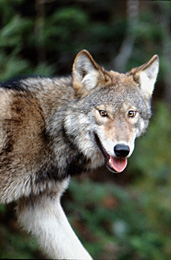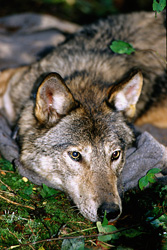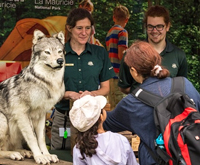Conserving the Eastern Wolf population in La Mauricie National Park

The Eastern Wolf (Canis sp. cf. lycaon), which once ranged throughout all of eastern North America, owed much of its decline to human activities. Not only did humans settle in their territory; they also launched numerous extermination efforts. Many people feared the "big bad wolf." And although those fears had little basis in fact, they resulted in serious declines in wolf habitat and populations. The Eastern Wolf is now limited to Ontario and Quebec. In 2001, it was added to the list of Canadian species at risk. To halt its decline in La Mauricie National Park (MNP), the employees quickly understood that biological studies were no longer enough and that the public needed to be engaged and consulted.
Calling on social sciences for help
The Eastern Wolf plays an important role in the ecosystem of La Mauricie National Park. Since they feed on beavers, white-tailed deer and moose, the wolves help maintain their populations at sustainable levels. Keeping numbers in balance is important to preserving the richness and diversity of plant species in the park, and indeed, the integrity of the entire forest ecosystem.
To assess the situation for the La Mauricie wolves, Parks Canada conducted an extensive scientific study. The protection of the two packs that occur in the park is not assured. The two wolf packs in La Mauricie National Park regularly cover a whopping 500 to 700 km2. Even La Mauricie, which protects 536 km2, cannot contain them. Once the wolves travel beyond park boundaries, they are subject to road traffic, hunting and trapping.
Parks Canada decided to launch an interpretation and communications program to interest local people in protecting the wolves. To learn about local perspectives, park managers called on social science specialists from Parks Canada to assess the human and social dimensions of wolf conservation.
Everyone has an opinion about wolves

From the beginning, Marie-Andrée Leith, the study's senior analyst, saw herself as a liaison between the communities and the park. She wasn’t content to develop her methodology in isolation from stakeholders. At the information sessions, she listened to participants from the various groups whose activities directly affected the wolves. “Discussing wolves with communities is a delicate matter,” she said. “It’s a sensitive topic and everyone has an opinion on it.”
Armed with the knowledge of the different perspectives and issues, the study team developed questionnaires and validated them with park managers and community representatives. The team then launched a major consultation with hunters, trappers, local residents and park visitors to determine their attitudes, perceptions, knowledge and behaviour regarding the wolf.
Besides community groups, the study team also involved Memorial University and the Quebec Department of Natural Resources and Wildlife. To ensure their study reflected best practices, they incorporated the methodology developed by the Working Group on Large Carnivores in Europe, part of the Species Survival Commission of the International Union for Conservation of Nature (IUCN).
Getting the facts straight and learning to love the wolf


The consultation revealed, among other things, that the number of wolves in the park was overestimated. "Before the activity, I didn't want to protect wolves because I didn't think they were at risk." said one respondent. "I thought that there were some 300 wolves in the region. Now, I believe it is important that Parks Canada continue its efforts to protect the species. It's part of its mandate."
In fact, the populations are closer to 20 wolves (two wolf packs of 5-10 animals each). And as people learned the facts, the majority of study participants – some 75 percent – came to recognize the importance of maintaining wolf populations.
But it was more the study process itself that provoked the greatest changes. By participating in the research, people were actively engaged. They began to feel a sense of ownership and responsibility. Most wanted to be kept informed about wolf management in the park. This innovative approach produced encouraging results for park managers and generated interest among other parks across Canada.
Respecting local concerns

© Fred Klus / MLCP
If conservation programs are to succeed, park managers need to understand the perceptions, values and behaviours and provide the knowledge people need. The consultation has helped public education specialists better target their messages to different audiences and will continue to serve as a model for other public awareness campaigns.
- Date modified :